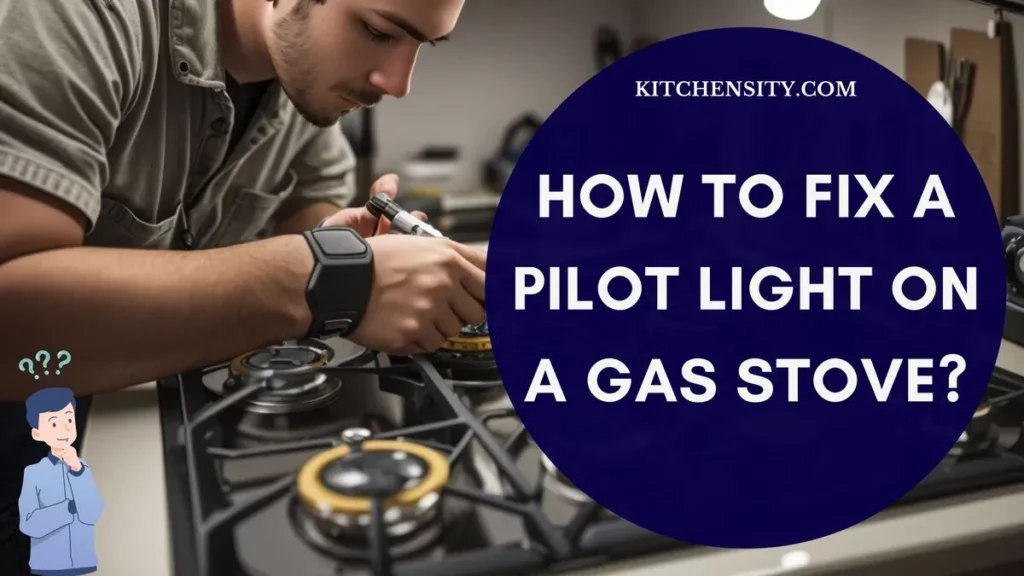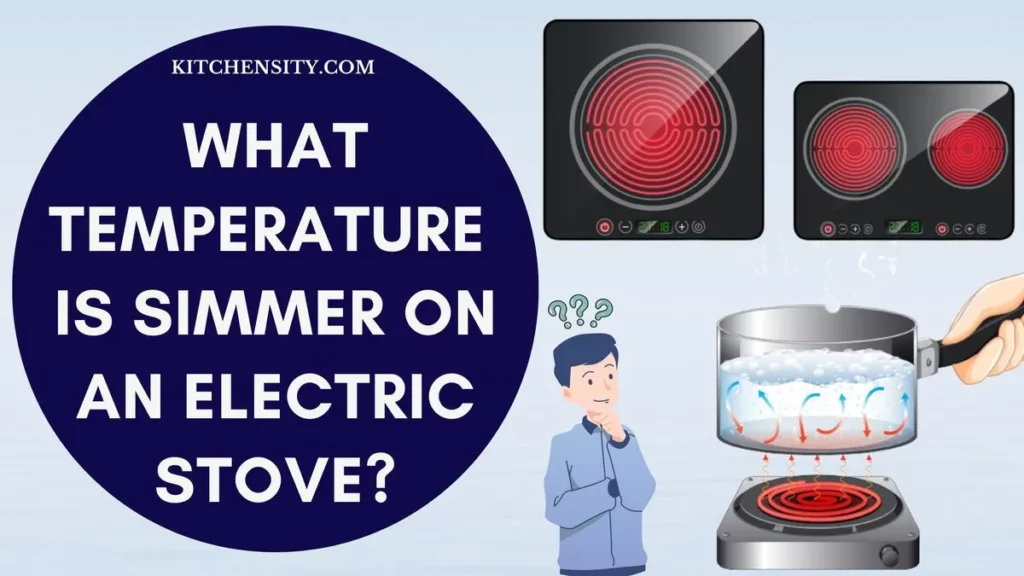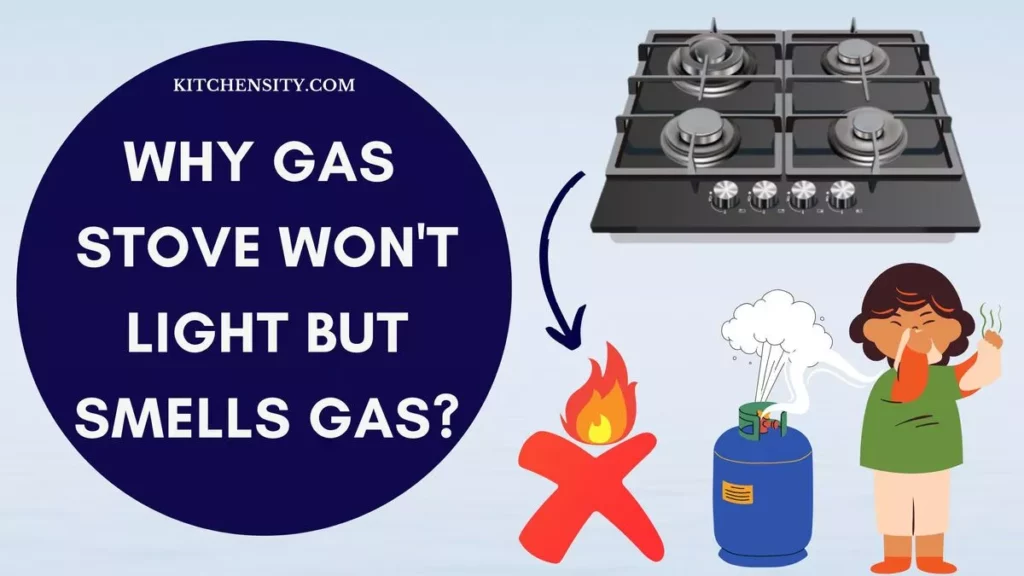Gas stoves are a popular choice for cooking due to their efficiency and precision.
However, a common issue that can arise is a malfunctioning pilot light. A pilot light that won’t stay lit or is not igniting can be frustrating.
In this article, we will guide you through the steps to fix a pilot light on a gas stove, ensuring your kitchen stays functional and safe.
Whether you’re a seasoned DIY enthusiast or just looking to address a common household issue, mastering the art of fixing a pilot light will empower you to keep your gas stove running smoothly and safely.
So, let’s dive in and learn how to restore the heart of your kitchen appliance.

Table of Contents
- 1 How To Fix A Pilot Light On A Gas Stove?
- 2 What Is A Pilot Light?
- 3 Safety First – Before Fixing The Pilot Light
- 4 Step-By-Step Guide To Fix A Pilot Light On A Gas Stove
- 5 Why Won’t The Pilot Light Light On My Gas Stove?
- 6 Is It Dangerous If The Pilot Light Goes Out On Stove?
- 7 What To Do If Pilot Light Goes Out On Stove?
- 8 How To Relight A Pilot Light On A Gas Stove?
- 9 How To Fix Electric Pilot Light On Gas Stove?
- 10 How To Clean A Pilot Light On A Gas Stove?
- 11 Will I Smell Gas If The Pilot Light Is Out?
- 12 Can A Pilot Light Cause Carbon Monoxide?
- 13 Final Thoughts: How To Fix A Pilot Light On A Gas Stove?
- 14 Frequently Asked Questions (FAQs)
How To Fix A Pilot Light On A Gas Stove?
Start by turning off the gas supply and ensuring proper ventilation. Access the pilot light assembly, clean the pilot tube, and relight the pilot by turning the valve to “Pilot” and using a long lighter or match. Monitor the pilot light to ensure it stays lit, and if issues persist, consult a professional technician.
Also Read – How To Fix The Gas Stove Igniter Not Sparking After Cleaning?
Refer below for a proper step-by-step guide.
What Is A Pilot Light?
A pilot light is a small, continuous flame that burns beneath the cooktop or oven of a gas appliance, such as a gas stove, water heater, or furnace. This flame serves as the ignition source for the appliance’s main burner.
In the context of a gas stove, the pilot light is responsible for lighting the gas when you turn on a burner, ensuring a steady and controlled flame for cooking.
It remains lit continuously, ready to ignite the gas when needed. If the pilot light goes out or fails to stay lit, it can disrupt the proper functioning of the appliance, and fixing it is essential for safety and functionality.
Common Issues Of Pilot Light
Common issues with a pilot light on a gas appliance, such as a gas stove or water heater, can include:
- Pilot Light Won’t Stay Lit: In this scenario, the pilot light initially ignites but then goes out shortly after lighting it. This can be caused by various factors, including a dirty pilot assembly, a malfunctioning thermocouple, or a weak pilot flame.
- Pilot Light Won’t Ignite: If you can’t get the pilot light to ignite in the first place, it may be due to issues like a clogged pilot tube, a faulty ignition system, or problems with the gas supply.
These issues can disrupt the normal operation of your gas appliance, and it’s important to address them promptly to ensure safety and functionality. Regular maintenance and troubleshooting can help resolve these common pilot light problems.
Also Read – Why Is My Gas Stove Not Clicking?
Safety First – Before Fixing The Pilot Light
Safety is of utmost importance when dealing with gas appliances and pilot lights. Here are some crucial safety measures to follow:
- Turning Off The Gas Supply: Before attempting any repairs or maintenance on a gas stove or any gas appliance, ensure your safety by turning off the gas supply. Locate the gas valve, typically located near the appliance, and shut it off. This prevents the flow of gas and reduces the risk of leaks or accidents.
- Ventilation: Ensure that the area around the gas stove is well-ventilated. Adequate ventilation helps disperse any gas leaks or fumes, reducing the risk of combustion or health hazards.
- No Open Flames: Keep open flames, such as candles or matches, away from the area where you are working. Gas leaks can be highly flammable, and open flames can lead to accidents.
- Protective Gear: Consider wearing protective gear, including gloves and safety goggles, to protect yourself from potential hazards while working on the appliance.
- Read The Manual: Always refer to the manufacturer’s instructions and safety guidelines provided in the appliance’s manual. Following these instructions ensures that you are taking the correct steps and precautions specific to your appliance.
- Use A Gas Detector: Invest in a gas leak detector, which can quickly identify any gas leaks in the vicinity. If you suspect a gas leak, evacuate the area immediately and contact a professional for assistance.
- Consult A Professional: If you are uncertain about any aspect of fixing the pilot light or encounter a problem you cannot resolve safely, it’s advisable to consult a qualified technician or plumber who specializes in gas appliances. Attempting complex repairs without the necessary expertise can be dangerous.
Also Read – Why Gas Stove Won’t Light But Smells Gas?
Step-By-Step Guide To Fix A Pilot Light On A Gas Stove
Fixing a pilot light on a gas stove may seem intimidating, but with the right guidance and precautions, it can be a manageable task. Below is a step-by-step guide that elaborates on how to fix a pilot light on a gas stove:
Step 1: Gather Your Tools
You’ll need the following tools for the task:
- Screwdriver: You’ll use this to access and disassemble parts of the stove.
- Small Wire Brush: This is for cleaning the pilot assembly.
- Soft Cloth: For wiping and cleaning components.
Step 2: Access The Pilot Light Assembly
To reach the pilot light assembly, follow these steps:
- Remove Burner Grates: Lift the burner grates from the stove’s cooktop. This allows access to the pilot light assembly beneath.
- Lift The Cooktop: Depending on your stove model, you may need to lift the cooktop or remove a cover to access the pilot light assembly. Use the screwdriver to carefully remove any necessary parts.
Step 3: Cleaning The Pilot Tube
A dirty pilot tube can prevent the pilot light from staying lit. Here’s how to clean it:
- Identify The Pilot Tube: Locate the pilot tube, a small, narrow tube leading from the gas supply to the pilot light.
- Use The Wire Brush: Gently use the wire brush to clean any debris or soot from the pilot tube. Be thorough but careful not to damage the tube.
- Wipe Clean: Use a soft cloth to wipe away any remaining residue from the tube.
Also Read – How To Fix A Yellow Flame On A Gas Stove?
Step 4: Relighting The Pilot Light
Now that the pilot tube is clean, it’s time to relight the pilot light:
- Locate The Pilot Light Valve: Identify the pilot light valve, usually located near the front of the cooktop.
- Turn The Valve To Pilot: Turn the valve to the “Pilot” position and press it down. This allows gas to flow to the pilot light.
- Ignite The Pilot Light: Use a long lighter or match to ignite the pilot light. Hold the valve down for a minute or two after ignition to ensure the pilot light stays lit.
Step 5: Adjusting The Pilot Flame
For optimal performance, you can fine-tune the pilot flame:
- Access The Adjustment Screw: Find the adjustment screw near the pilot light valve.
- Fine-Tune The Flame: Use the screwdriver to turn the adjustment screw slightly, making the flame larger or smaller as needed. This adjustment helps ensure a stable and efficient pilot light.
Step 6: Test Your Stove
After completing these steps, turn on a burner to test your stove. The pilot light should remain lit, and the burner should ignite without any issues.
If the problem persists, or if you encounter any difficulties during the process, it’s advisable to consult a professional technician or plumber who specializes in gas appliances.
Safety should always be the top priority when working with gas appliances.
Also Read – Orange Flame On The Gas Stove: Causes And Fixes
Why Won’t The Pilot Light Light On My Gas Stove?
If the pilot light on your gas stove won’t light, it can be due to several reasons. Here are some common causes and troubleshooting steps:
- Gas Supply Issues: Ensure that the gas valve leading to the stove is turned on. If it’s off, the pilot light won’t receive gas to ignite.
- Pilot Light Assembly Problems:
- Dirty or Clogged Pilot Tube: A common issue is a pilot tube blocked by dirt or debris. Use a small wire brush to gently clean the pilot tube. Make sure it’s free from any obstructions.
- Thermocouple Malfunction: The thermocouple is a safety device that senses the pilot flame’s heat. If it’s faulty or not positioned correctly, it may prevent the pilot light from staying lit. Check its position and ensure it’s in contact with the pilot flame.
- Pilot Orifice Blockage: The pilot orifice, a small opening where gas flows, can become blocked over time. Carefully remove the pilot assembly and clean the orifice with compressed air or a thin wire.
- Ignition Problems:
- Faulty Piezoelectric Igniter: If your stove has an igniter button, it might be defective. Test it by pressing the button while observing the pilot light. If it doesn’t spark or create a spark strong enough to ignite the pilot, it needs replacement.
- Electronic Ignition Module Issues: Modern stoves often have electronic ignition systems. If this module is malfunctioning, it won’t generate the spark needed to light the pilot. A technician may need to replace it.
- Air Flow And Ventilation: Ensure that the stove’s location isn’t too drafty. Strong drafts can blow out the pilot light. Consider using a draft guard or sealing any drafts around the stove area.
- Gas Pressure Problems: In some cases, low gas pressure in your home’s supply line can affect the pilot light’s ability to stay lit. Contact your gas utility provider to check and adjust the pressure if needed.
- Safety Precautions: Gas stoves are equipped with safety systems that may shut off the gas supply if they detect a problem. If you’ve tried troubleshooting and the pilot still won’t light, contact a qualified technician to inspect the safety systems.
Remember that safety should be your top priority when dealing with gas appliances. If you’re unsure about any aspect of troubleshooting the pilot light or if you’re unable to resolve the issue, it’s advisable to consult a professional technician or plumber who specializes in gas appliances.
They have the expertise to diagnose and fix more complex problems and ensure the safe operation of your gas stove.
Also Read – Brass Burners Vs Cast Iron Burners
Is It Dangerous If The Pilot Light Goes Out On Stove?
If the pilot light on your gas stove goes out, it can potentially be dangerous if not addressed properly. Here are some reasons why it’s important to take the situation seriously:
- Gas Buildup: When the pilot light goes out, the flow of gas to the burner is not automatically shut off. This means that gas can continue to escape into the room. Natural gas is highly flammable, and in the presence of an open flame or spark, it can lead to a fire or explosion.
- Carbon Monoxide (CO) Risk: Incomplete combustion of natural gas can produce carbon monoxide (CO), a colorless, odorless gas that is toxic when inhaled. If the pilot light is out, it can result in a buildup of carbon monoxide in the room, posing a serious health risk to those in the vicinity.
- Gas Leaks: A malfunctioning pilot light may be indicative of other issues within the stove, such as a faulty thermocouple or gas valve. These problems can potentially lead to gas leaks, which can be hazardous and increase the risk of fire or explosion.
To ensure safety when the pilot light goes out:
- Ventilation: Ventilate the area by opening windows and doors to allow any escaped gas, including carbon monoxide, to dissipate.
- Avoid Ignition Sources: Do not attempt to relight the pilot light or use any electrical appliances, matches, or open flames in the area until you’re sure it’s safe.
- Turn Off the Gas: Locate the gas valve near the stove and turn it off to stop the flow of gas. This is a crucial step in preventing any further gas buildup.
- Seek Professional Help: Contact a qualified technician or plumber who specializes in gas appliances to inspect and relight the pilot light. They can also diagnose and fix any underlying issues to prevent recurrence.
- Install CO Detectors: As a precaution, install carbon monoxide detectors in your home, especially near gas appliances. These detectors can alert you to dangerous levels of carbon monoxide and provide an added layer of safety.
While a pilot light going out on a gas stove is not inherently dangerous, it can lead to potentially hazardous situations if not handled correctly. Taking immediate safety precautions and seeking professional assistance is essential to mitigate the risks associated with an extinguished pilot light.
Also Read – Do Gas Stoves Need To Be Vented?
What To Do If Pilot Light Goes Out On Stove?
If the pilot light on your gas stove goes out, it’s important to take the following steps to safely relight it:
- Ventilation: Open windows and doors in the area to ensure proper ventilation. This helps dissipate any residual gas that may have escaped when the pilot light went out. Adequate ventilation reduces the risk of gas buildup and the presence of carbon monoxide.
- Turn Off The Gas: Locate the gas valve near the stove and turn it off. This stops the flow of gas to the stove and prevents any further gas from escaping. The gas valve typically has a “Pilot” and “Off” setting.
- Wait: Give the area a few minutes to allow any remaining gas to disperse completely. During this time, avoid using any electrical appliances, open flames, or ignition sources in the vicinity.
- Access The Pilot Light Assembly: Lift the burner grates and, if necessary, remove any covers or components to access the pilot light assembly beneath the cooktop. This may require using a screwdriver to remove certain parts.
- Read The Manufacturer’s Instructions: Consult your stove’s manual for specific instructions on relighting the pilot light. It should provide step-by-step guidance tailored to your appliance.
- Turn The Pilot Valve To “Pilot”: Locate the pilot light valve, usually near the front of the cooktop. Turn it to the “Pilot” position. You may need to push or press the valve down as you do this.
- Ignite The Pilot Light: Use a long lighter or match to ignite the pilot light. Hold the flame near the pilot assembly while continuing to press the pilot valve down for a minute or two after ignition. This allows the thermocouple to heat up and keep the pilot light lit.
- Observe The Pilot Light: Watch the pilot light to ensure it remains lit. If it goes out immediately after lighting or won’t stay lit, there may be an underlying issue that requires professional attention.
- Reassemble The Stove: Carefully put back any components, such as burner grates or covers, that you removed to access the pilot light assembly.
- Turn On The Gas: Once the pilot light is successfully lit and stays lit, you can turn the gas valve back to the “On” position.
- Test The Stove: Turn on a burner to ensure that it lights properly and stays lit. If everything functions as it should, your stove is back in working order.
- Monitor For A While: Keep an eye on the stove for a little while after relighting the pilot light to make sure it remains stable and safe.
If you encounter difficulties during this process, or if the pilot light won’t stay lit, it’s advisable to contact a qualified technician or plumber who specializes in gas appliances. They can diagnose and fix any underlying issues to ensure the safe and efficient operation of your gas stove. Safety should always be the top priority when working with gas appliances.
Also Read – How To Properly Vent A Gas Stove?
How To Relight A Pilot Light On A Gas Stove?
Relighting the pilot light on a gas stove is a straightforward process. Follow these steps carefully to safely relight the pilot light:
Note: Before starting, ensure proper ventilation in the area, turn off any open flames or ignition sources, and locate the gas shut-off valve near the stove to be prepared in case of any issues.
- Access The Pilot Light Assembly: Lift the burner grates on your gas stove to access the pilot light assembly beneath the cooktop. You may need to remove any covers or components that obstruct access.
- Locate The Pilot Light Valve: Near the front of the cooktop, you’ll find the pilot light valve. It’s usually marked as “Pilot” and “On.”
- Turn The Valve To “Pilot”: Rotate the pilot light valve to the “Pilot” position. This allows gas to flow to the pilot light assembly.
- Press And Hold The Valve: While holding the pilot light valve in the “Pilot” position, use a long lighter or match to ignite the pilot light.
- Keep The Valve Pressed: Continue pressing the pilot light valve down for about a minute after the pilot light ignites. This allows the thermocouple (a safety device) to heat up and signal that it’s safe to release the valve.
- Release The Valve: After a minute or when you’re confident that the pilot light is stable and staying lit, release the pilot light valve slowly. The pilot light should remain lit on its own.
- Observe The Pilot Light: Watch the pilot light for a few moments to ensure it stays lit without any flickering or going out. If it goes out immediately or repeatedly, there may be an underlying issue.
- Turn On The Gas: Once the pilot light is successfully relit and stable, you can turn the gas valve back to the “On” position to allow gas to flow to the burners.
- Test The Stove: Turn on a burner to make sure it lights properly and stays lit. If the burner lights and functions correctly, your stove is back in working order.
- Monitor For A While: After relighting the pilot light, keep an eye on the stove for a little while to ensure that it continues to operate safely and without any issues.
If the pilot light goes out immediately after lighting or if it won’t stay lit, it’s important to address the issue promptly. Potential causes could include a dirty pilot assembly, a faulty thermocouple, or other technical problems.
In such cases, it’s advisable to contact a qualified technician or plumber who specializes in gas appliances to diagnose and resolve the issue safely. Safety should always be the top priority when working with gas appliances.
Also Read – Why Electric Stoves Take Forever To Boil Water?
How To Fix Electric Pilot Light On Gas Stove?
Electric pilot lights are not typically found on gas stoves. Pilot lights on gas stoves are usually lit manually or have electronic ignition systems. However, if you believe you have an electric pilot light issue, you may be referring to an electronic ignition problem.
Here’s how to troubleshoot and potentially fix an electronic ignition issue on a gas stove:
Note: Ensure that the gas supply is turned off and that you have proper ventilation before attempting any repairs.
- Safety First:
- Turn off the gas supply to the stove.
- Open windows and doors to ventilate the area.
- Access The Electronic Ignition System: Lift the burner grates and, if necessary, remove any covers or components to access the electronic ignition system beneath the cooktop.
- Check For Power:
- Make sure the stove is plugged in or connected to a power source.
- Verify that the circuit breaker or fuse associated with the stove is not tripped or blown.
- Inspect The Ignition Component:
- Locate the electronic ignition module, which is responsible for creating sparks to ignite the burners.
- Check the wiring connections to ensure they are secure.
- Clean The Ignition Components: Use a soft brush or compressed air to remove any dust, dirt, or debris from the ignition components. This buildup can interfere with proper ignition.
- Check The Spark Gap: Ensure that the spark gap between the igniter and the burner is clean and free from obstructions. It should be about 1/8 inch.
- Test The Ignition: Turn on a burner while observing the igniter. You should see and hear a series of sparks. If you don’t, there may be an issue with the ignition module.
- Replace The Ignition Module:
- If cleaning and checking the connections do not resolve the issue, it’s possible that the ignition module is faulty and needs replacement.
- Consult your stove’s manual for guidance on finding a compatible replacement part.
- Reassemble The Stove: Carefully put back any components, such as burner grates or covers, that you removed to access the electronic ignition system.
- Turn On The Gas: Once you’ve resolved the electronic ignition issue and are confident in the repair, you can turn the gas supply back on.
- Test The Stove: Turn on a burner to ensure that it lights properly with the electronic ignition functioning as expected.
- Monitor For A While: After the repair, keep an eye on the stove for a little while to ensure that it continues to operate safely and without any issues.
If you are uncomfortable with any of the steps involved or if the issue persists after troubleshooting, it’s advisable to contact a qualified technician or appliance repair specialist. They can diagnose and fix more complex issues with the electronic ignition system, ensuring the safe and efficient operation of your gas stove.
Also Read – How Hot Do Electric Stove Burners Get?
How To Clean A Pilot Light On A Gas Stove?
Cleaning a pilot light on a gas stove is essential to ensure it functions properly. Here are the steps to clean a pilot light:
Note: Before starting, turn off the gas supply to the stove and make sure the area is well-ventilated to prevent gas buildup. Additionally, ensure the pilot light is not currently lit.
- Access The Pilot Light: Lift the burner grates on your gas stove to access the pilot light assembly beneath the cooktop. You may need to remove any covers or components that obstruct access.
- Gather Your Cleaning Tools: You will need a small wire brush and a soft cloth or paper towel.
- Identify The Pilot Tube: Locate the pilot tube, a small, narrow tube that leads from the gas supply to the pilot light. It is the component responsible for delivering gas to the pilot light.
- Clean The Pilot Tube: Use the small wire brush to gently clean the pilot tube. Insert the brush into the tube and carefully scrub away any debris, soot, or blockages. Be thorough but gentle to avoid damaging the tube.
- Wipe Clean: After brushing the pilot tube, use a soft cloth or paper towel to wipe away any remaining residue or particles. Ensure that the tube is completely clean and free from obstructions.
- Inspect The Thermocouple: While you’re in the area, inspect the thermocouple, a safety device positioned near the pilot light. Ensure that it is clean and free from any obstructions as well.
- Reassemble The Stove: Carefully put back any components, such as burner grates or covers, that you removed to access the pilot light assembly.
- Turn On The Gas: Once the pilot light and surrounding components are cleaned and reassembled, you can turn the gas supply back on.
- Relight The Pilot Light: Follow the manufacturer’s instructions or the steps mentioned earlier to safely relight the pilot light.
- Test The Stove: Turn on a burner to ensure that it lights properly and stays lit with the cleaned pilot light functioning as expected.
- Monitor For A While: After cleaning and relighting the pilot light, keep an eye on the stove for a little while to ensure that it continues to operate safely and without any issues.
Also Read – Gas Stove Leaking Gas From Burner
Regularly cleaning the pilot light and surrounding components of your gas stove helps maintain its efficiency and safety. It prevents blockages that can lead to pilot light issues or gas flow problems.
If you encounter difficulties during this process or if the pilot light continues to malfunction after cleaning, it’s advisable to contact a qualified technician or plumber who specializes in gas appliances for further inspection and repairs. Safety should always be the top priority when working with gas appliances.
Will I Smell Gas If The Pilot Light Is Out?
If the pilot light on your gas appliance, such as a gas stove, water heater, or furnace, is out, you may not necessarily smell gas immediately. This is because gas appliances are equipped with safety mechanisms to prevent the release of unburned gas into your home.
However, there are situations where you might detect the odor of gas if the pilot light is out:
- Gas Leak: If there is a gas leak elsewhere in the gas supply system or in the appliance itself, you may smell gas even if the pilot light is out. Gas leaks are rare but can occur due to damaged pipes, loose connections, or faulty gas valves.
- Gas Odorant: Natural gas is odorless, but gas companies add a chemical called mercaptan to give it a distinct, unpleasant odor. This is done to make it easier to detect gas leaks. So, if there’s a gas leak, you should be able to smell the mercaptan.
- Drafty Area: In some cases, if the area around your gas appliance is very drafty and there’s a strong wind blowing down the chimney or vent, it might cause a temporary backflow of air and a faint odor of gas.
- Incomplete Combustion: If the pilot light repeatedly goes out due to an issue like a dirty pilot assembly, it can lead to incomplete combustion when it’s relit. This can result in the release of a small amount of unburned gas, which may produce a faint odor.
It’s important to note that if you do detect the smell of gas, even if the pilot light is out, you should take it seriously and follow safety procedures:
- Ventilation: Ventilate the area by opening windows and doors to allow gas to disperse.
- Turn Off Gas: Locate the gas shut-off valve near the appliance and turn it off to stop the flow of gas.
- Avoid Open Flames: Do not use matches, lighters, or any electrical switches in the area where you smell gas.
- Evacuate: If you suspect a gas leak, evacuate the building immediately and contact your gas utility provider or emergency services from a safe location.
While a pilot light being out may not directly lead to the smell of gas, it’s crucial to be cautious and attentive to any unusual odors, as they could indicate a gas leak or other issues that need prompt attention to ensure your safety.
Also Read – How To Convert A Natural Gas Stove To Propane?
Can A Pilot Light Cause Carbon Monoxide?
A pilot light itself does not produce carbon monoxide (CO). However, there are scenarios in which a malfunctioning or poorly maintained pilot light in a gas appliance can indirectly lead to the production of carbon monoxide:
- Incomplete Combustion: If the pilot light is not burning properly due to issues like a dirty pilot assembly, clogged pilot tube, or a weak flame, it may result in incomplete combustion of natural gas. Incomplete combustion can produce carbon monoxide as a byproduct. This is especially concerning in enclosed spaces because carbon monoxide is a colorless, odorless gas that can be toxic when inhaled in high concentrations.
- Blocked Ventilation: A malfunctioning pilot light can be a sign of a larger problem within the gas appliance, such as a blocked flue or vent. If the venting system is obstructed, it can prevent the proper venting of combustion gases, including carbon monoxide, out of the home. This can lead to a buildup of carbon monoxide indoors.
- Faulty Safety Devices: Gas appliances are equipped with safety mechanisms like the thermocouple, which is responsible for shutting off the gas supply if the pilot light goes out. If the safety devices fail, it can result in gas leaks and improper combustion, potentially leading to carbon monoxide production.
To mitigate the risk of carbon monoxide production related to a pilot light, it’s essential to:
- Regularly maintain and clean the pilot light and gas appliance to ensure proper combustion.
- Install carbon monoxide detectors in your home, especially in areas near gas appliances and sleeping areas. These detectors can alert you to dangerous levels of carbon monoxide and provide early warning in case of any issues.
- Be attentive to any signs of a malfunctioning pilot light, such as a weak or flickering flame, and address the issue promptly.
- Ensure proper ventilation in areas with gas appliances to allow the safe dispersion of combustion gases.
- Have your gas appliances inspected and serviced regularly by a qualified technician to ensure they are functioning safely and efficiently.
While a pilot light itself does not directly produce carbon monoxide, it can contribute to carbon monoxide production if not functioning correctly or if there are issues with the gas appliance’s overall operation. Regular maintenance and safety precautions are crucial to prevent such risks.
Also Read – Do Gas Stoves Turn Off Automatically?
Final Thoughts: How To Fix A Pilot Light On A Gas Stove?
In conclusion, knowing how to fix a pilot light on a gas stove is a valuable skill for any homeowner. A malfunctioning pilot light can disrupt the functionality of your stove, impacting your daily cooking routines. However, it’s crucial to approach this task with caution and prioritize safety above all else.
The process of fixing a pilot light involves a series of steps, including turning off the gas supply, accessing the pilot light assembly, cleaning the pilot tube, and relighting the pilot light. Regular maintenance and cleaning of the pilot light can help prevent issues and ensure safe operation.
Moreover, safety should always be at the forefront of your mind when working with gas appliances. Proper ventilation, gas shut-off procedures, and vigilance for gas odors are essential aspects of maintaining a safe environment.
If you encounter difficulties during the process, or if the pilot light continues to malfunction after troubleshooting, it’s advisable to seek the assistance of a qualified technician or plumber who specializes in gas appliances. They possess the expertise to diagnose and resolve complex issues, guaranteeing the safe and efficient operation of your gas stove.
So, by following the outlined steps, prioritizing safety, and seeking professional assistance when necessary, you can successfully fix a pilot light on your gas stove, ensuring it functions optimally for your cooking needs.
Also Read – How Long Can You Leave An Electric Stove On?
Frequently Asked Questions (FAQs)
-
Is It Safe To Relight The Pilot Light Myself?
Yes, it’s safe as long as you follow proper safety procedures and guidelines. Always turn off the gas supply before attempting any repairs.
-
Why Does The Pilot Light Go Out Frequently?
Common reasons include a dirty pilot tube, a faulty thermocouple, or a drafty area around the stove. Cleaning the pilot tube is a good place to start.
-
Can I Use A Lighter Or A Match To Relight The Pilot Light?
Yes, a long lighter or match is an effective way to ignite the pilot light if the stove’s ignition system isn’t working.
-
What If The Pilot Light Still Won’t Stay Lit After Cleaning?
If cleaning and relighting the pilot light doesn’t solve the issue, it may be a problem with the thermocouple or gas valve. It’s advisable to consult a professional technician.
-
How Often Should I Clean The Pilot Light?
Cleaning the pilot light once a year or when you notice it’s not working correctly is usually sufficient to maintain its functionality.
🔧 Stove Expert | 🔥 Gas Guru | 🏠 DIY Enthusiast | 🎨 Painter Extraordinaire
John Davis is your go-to source for all things stoves, from expert repairs to maintenance tips. With a deep understanding of gas systems, including natural and propane, John ensures your kitchen stays cooking safely. His passion for DIY home and kitchen projects shines through his stunning paint transformations. Trust John to bring warmth and functionality to your home, one stove at a time.






